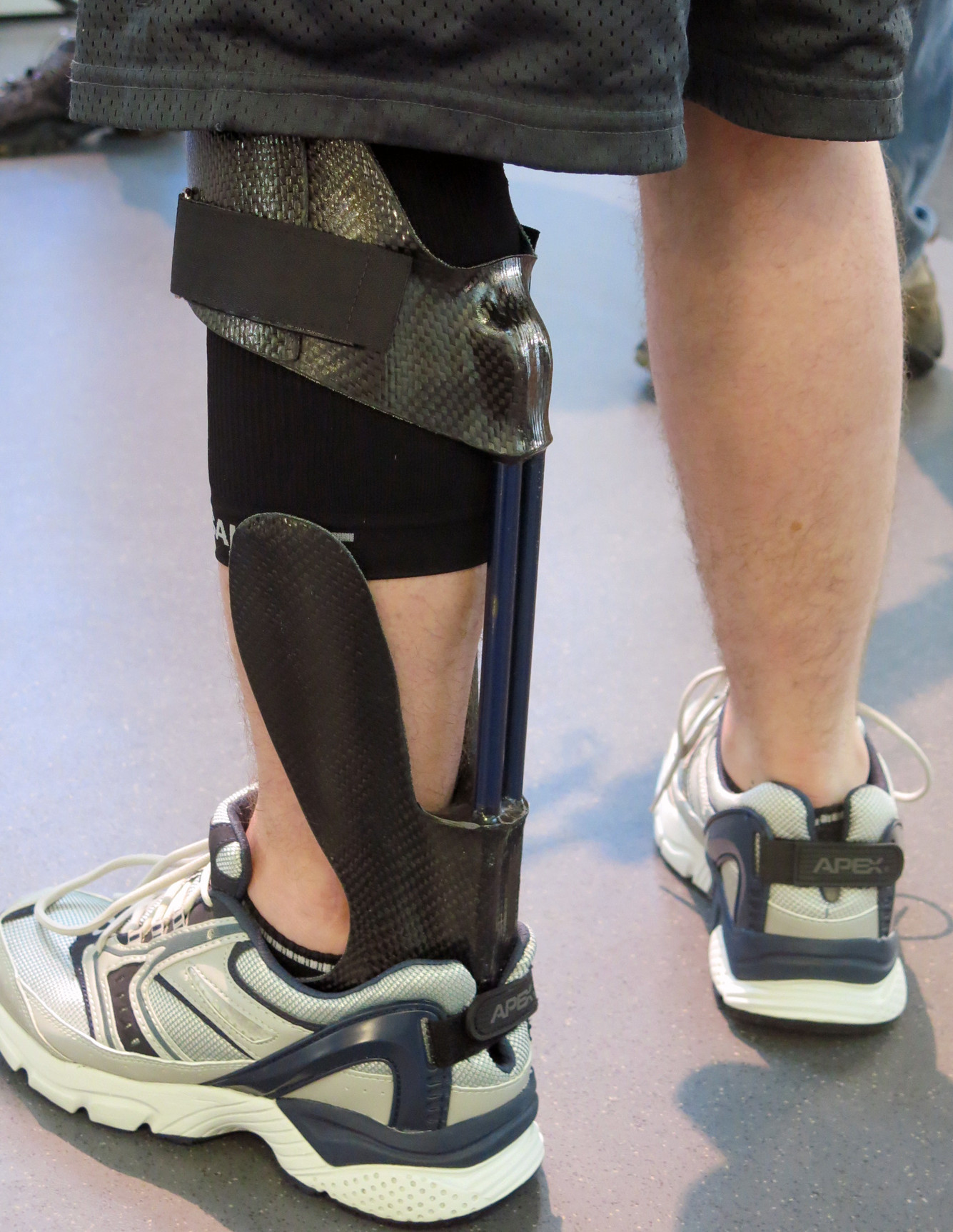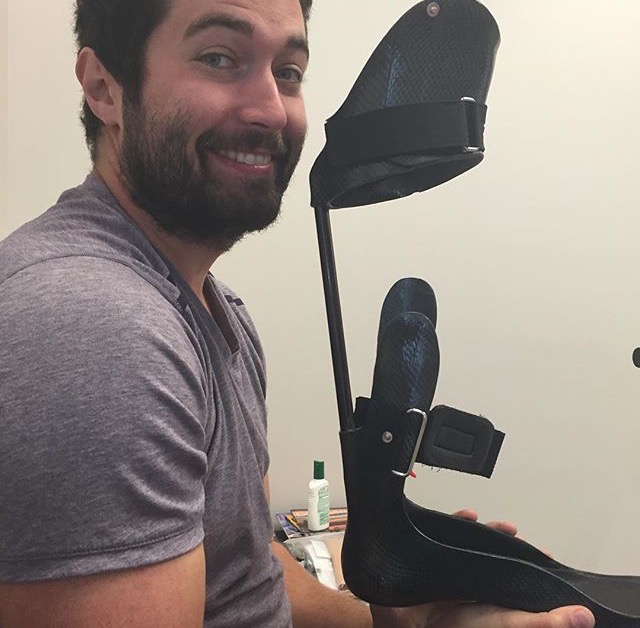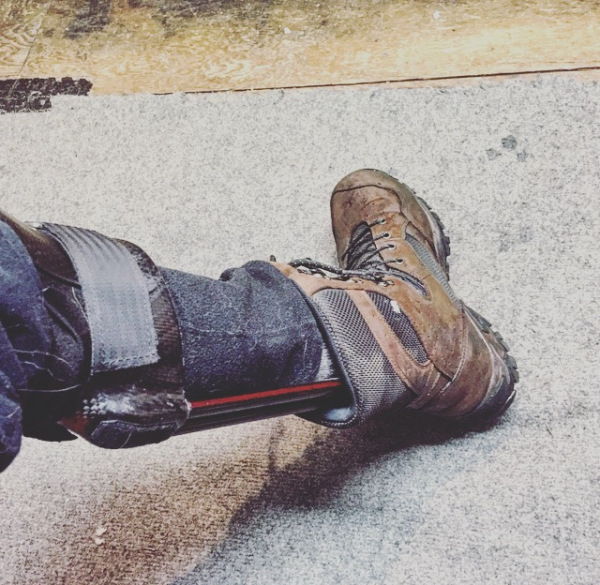Orthotic brace helps New England farmer live without pain
For roughly the last dozen years of Phil Stevens’ life, pain has been a daily companion. Stevens, a third-generation dairy farmer on a 1,000-acre spread in Barre, Massachusetts, fell off the metal roof he was building in April 2003. He landed on the concrete below.

Phil Stevens, of Carter and Stevens Farm in Barre, shows the IDEO brace that frees him from leg pain. T&G Staff/Christine Peterson. The Worcester Telegram & Gazette
By Betta Ferrendelli, The O&P Edge February 8, 2016
Stevens, who was 46 at the time, says he thought the fall wasn’t that bad. It turned out, however, that the fall was much worse than he could have imagined. He had badly broken the calcaneus—the heel bone—in each foot.
“It was right down to the marrow,” he says. “When a break is that bad and the cartilage is gone, you learn right away that there’s not much you can do about it.”
Stevens endured two ten-hour surgeries during which surgeons placed thin screws in both heels. They told Stevens that it was as good as they could do. “It was like screwing Jell-O to a wall,” Stevens says. “You get what you get and you have to learn to deal with it—and what I got was horrible.”
Stevens spent most of that summer in a wheelchair and learning to walk again. He had to rely on his wife and their four children to help him run the farm. “It was a life-changing event for us,” he says.
| Giving Up, Not A Chance |
Despite the nearly debilitating pain that Stevens endured in the years after his accident, giving up was not an option. He could only tolerate standing for a maximum of about an hour. When he would stand to start his day, “It was like a timer had started ticking,” he says. “I had to use that hour preciously.”
When he could no longer stand due to the pain in his heels, Stevens says he would do jobs on the farm that allowed him to sit down, such as driving a truck or a tractor. As a result, his physical health began to deteriorate. “I wasn’t using the muscles in my legs any longer,” he says.
Stevens tried taking pain medication. It allowed him to stay on his feet longer and work more. The pain, however, would be so bad the next day even standing for an hour was impossible. Stevens says he traded the pain medication for aspirin.

The IDEO brace helps transfer energy so the wearer can step forward. Melissa Block NPR
| Let’s Amputate |
Stevens tried everything he could to eliminate the pain, from using various types of AFOs to wearing a leather boot, which he called “a piece of junk.” He also tried wearing a ski boot, but “nothing really worked,” he says. “The pain was always there.”
Eventually the pain became so unbearable that he considered having his feet amputated. “I was ready to try anything at that point, Stevens says.” It was an idea his daughter Nellie Zarif, who was 15 years old when her father had the accident, quickly put to rest. By that time, Zarif had graduated from college and was preparing to enter the O&P profession. Now a certified prosthetist with Hanger Clinic’s Worcester, Massachusetts, patient care facility, she says her decision to enter O&P wasn’t because of her father, but because she has a passion for helping people.
After the accident, Zarif says she remembers her father going through months and months of rehabilitation. “He used to crawl everywhere to get around,” says Zarif, who is married now with two children. Her husband also works on the dairy farm.
When it came to amputation, Zarif says her father would often say to her, “You make people walk every day.” She explained to him that amputation was not a panacea. “I told him it was not a solution at this point. I told him about phantom [limb] pain and that there would be a lot of rehab.”
Zarif says her father’s dire situation made her exhaust every effort to find a solution to end his pain, including trying the Arizona Optima Brace, which helped alleviate his pain on a short-term basis.

Ryan Blanck. Meet the inventor who has helped operators and civilians regain their lives. After helping nearly 600 soldiers return to the fight with his new invention, Ryan left the Center for the Intrepid in 2013 in order to become the National ExoSym™ Program Director for the Hanger Clinic. SOFREP News
| A New Discovery |
In February 2014, one of Zarif ’s colleagues learned about the Intrepid Dynamic Exoskeletal Orthosis (IDEO) and an orthotist/prosthetist named Ryan Blanck, CPO/L, through attending a conference in Las Vegas. The IDEO is a type of AFO that supports and protects an injured lower limb and restores function to the patient. It works by offloading the limb and allowing the patient to operate the lower limb in a way that avoids pain.
Zarif did her own research on the IDEO before she contacted Blanck. “This is it,” she remembers thinking.
Blanck designed the IDEO when he was working at the Center for the Intrepid, San Antonio, in 2009. His goals in developing and designing the IDEO were to reduce pain and restore mobility to active-duty and retired service members with limb salvage conditions as a way for them to avoid amputation. Each IDEO is a custom-fit design that provides increased dynamics and energy return to give patients more agility and to enable them to participate in high-impact activities, including running, after a devastating lower-limb injury, Blanck says. Many of the more than 600 service members who have received an IDEO have returned to various forms of active duty, including combat deployment, he adds.
Blanck says it wasn’t long before he began to hear from civilians who wanted to know when the IDEO would be available on the open market.

Dave’s journey to get the ExoSym. After severely shattering his ankle in a mountain biking accident twelve years ago at the age of 17, Dave managed to push through the recovery, ignoring the pain – determined to live life with no regrets. Tabor Melwood ensured the couple that they were not alone, but first suggested a meeting with Dr. Jacquie Hebert and her team up in Edmonton AB before considering an amputation. Dr. Hebert suggested that Dave try an alternative – a new limb salvage device called the ExoSym at the Hanger Clinic in Gig Harbor WA. She told them about a recently referred patient who had achieved great success with her pain levels in the device and was leading an active lifestyle once again.
| ExoSym is Born |
Blanck found an opportunity to work with Hanger Clinic in Gig Harbor, Washington, as the national upper extremity specialist for the Northwest Region and national IDEO (now known as ExoSym™-IDEO) program director in September 2013. It was there Blanck designed the ExoSym kinetic orthosis, an evolution of the IDEO that is lighter, thinner, and stronger than the original version, to restore high-level activity and function to patients with severe lower-limb conditions or injuries.
It is within the Gig Harbor facility, which Blanck describes as a “5,000-square-foot, cross-fit-style gym,” that he is now helping civilian patients from all over the world with the ExoSym.
Blanck says what makes the device work is that it is more like a hybrid prosthetic-orthotic design than a conventional orthosis. The upper section incorporates many prosthetic socket design concepts used in prosthetic limbs, he says. The ExoSym device has helped patients with limb salvage injuries, partial foot amputations, fractures, tarsal conditions, and sciatic nerve injuries, as well as various forms of spinal cord injuries. As a patient progresses through rehabilitation, the ExoSym may be required permanently, much like a prosthesis, or some patients may progress to using the device only part time, says Blanck.
| Skeptical, But Willing |
Stevens remembers when his daughter told him about the IDEO for civilians; he was skeptical but willing to give it a try. In September 2014, Stevens traveled to Gig Harbor with his wife and Zarif where he spent about two weeks getting his custom ExoSyms.
Stevens’ treatment, as with all patients, included a clinical evaluation, a fitting process, and an intense training regimen. “Phil was pretty committed,” Blanck says. Stevens’ success with the device came because of his “inherent drive and athleticism,” he says. “He’s a hardworking guy.” Stevens says he knew immediately when wearing his ExoSyms that they were different from anything else he had tried.
“It was amazing,” he says. They were so effective that while Stevens and his wife were in Washington, they traveled to Mount Rainier for a day hike. “There was no pain,” he says. “I could’ve kept going.”
His daughter also saw an immediate change in her father. “I saw it in his face,” Zarif says. “It was like a weight had been lifted.”
| Run Like a Spartan |

Sam’s advice for other device users is to wear it as much as possible and not to buy shoes too big because they won’t last long. (That’s a good point, if you buy them too big, you’ll start tripping & ripping through them. Not that I’ve done that before or anything… ☺) While Sam admits shoe shopping can be bit of a challenge, his favorite brands for the device are New Balance, Merrell & Meindl. Check out his cool hiking boots. ExoSym Patient Spotlight: Sam.
Stevens returned to New England nearly pain free and eager to return to work on the farm. Within the last year, Stevens’ former active self and strength have resurfaced. He is building a brewery on the farm with his son-in-law, which the family will begin operating this summer.
And there’s one more thing Stevens has taken up: Spartan racing. Since several of the races have taken place on his farm, he has taken an interest. “It inspired me to start running,” Stevens says.
The family decided to try out for a race. They submitted a demo tape and were accepted. They completed their race in Atlanta in December 2015 and it will air this spring. Though Stevens can’t say how well his family did, “It was quite an experience,” he says. How much did his ExoSym help him? “It was absolutely amazing,” Stevens says. “It made me Superman.”
| Betta Ferrendelli is a freelance writer based in Denver. |
Source The O&P Edge
| Further reading |
Can an integrated orthotic and rehabilitation program decrease pain and improve function after lower extremity trauma? Bedigrew KM, Patzkowski JC, Wilken JM, Owens JG, Blanck RV, Stinner DJ, Kirk KL, Hsu JR; Skeletal Trauma Research Consortium (STReC). Clin Orthop Relat Res. 2014 Oct;472(10):3017-25. doi: 10.1007/s11999-014-3609-7
Deployment after limb salvage for high-energy lower-extremity trauma, Patzkowski JC, Owens JG, Blanck RV, Kirk KL, Hsu JR; Skeletal Trauma Research Consortium (STReC). J Trauma Acute Care Surg. 2012 Aug;73(2 Suppl 1):S112-5
Return to running and sports participation after limb salvage, Owens JG, Blair JA, Patzkowski JC, Blanck RV, Hsu JR; Skeletal Trauma Research Consortium. J Trauma. 2011 Jul;71(1 Suppl):S120-4. doi: 10.1097/TA.0b013e3182219225
Can an ankle-foot orthosis change hearts and minds? Patzkowski JC, Blanck RV, Owens JG, Wilken JM, Blair JA, Hsu JR. J Surg Orthop Adv. 2011 Spring;20(1):8-18.
Also see
ExoSym Patient Spotlight: Sam ExoSymplyAmazing
IDEO brace gives troops, vets new life The San Diego Union-Tribune
The Miracle Manufacturers: Limb Salvage and the IDEO Team Time
Orthotic Brace Takes Soldiers From Limping To Leaping NPR
Meet the inventor who has helped operators and civilians regain their lives SOFREP News
Exosym: why you should care if you have cerebral palsy Cerebral Palsy Strong
Military prosthetics on pain detail for Barre man The Worcester Telegram & Gazette
